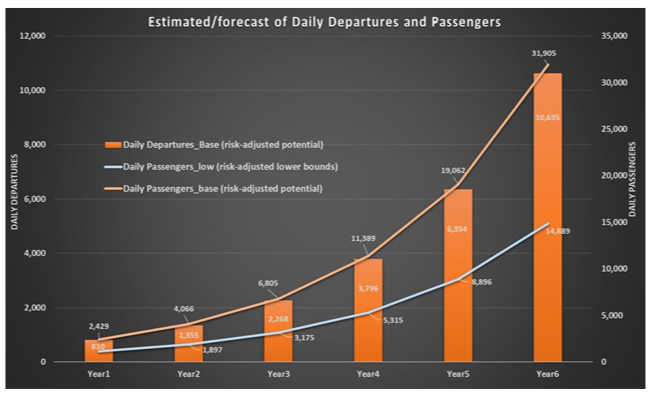
The US Federal Aviation Administration’s (FAA) latest aerospace forecasts predict 3.9 million departures per year in year six after entry into service (EIS) for advanced air mobility (AAM) air vehicles flying in the USA.
The following excepts are taken from the forecast text.
“Assuming EIS successful, AAM departures will then likely accelerate and reach almost 3.9 million a year in a very short time (i.e., by the end of Year 6), provided outstanding integration issues involving new entrants have been appropriately addressed and resolved,” say the latest FAA forecasts. “In the lower-case scenario estimate, the likely departures are expected to be around 207,000 to a level of 553,000 cumulatively by Year 2. It may likely reach around 2.7 million by end of the projection in Year 6.
“Although there are several aircraft under development for the AAM/UAM market, we assume relatively low load factors (e.g., 2-3 passengers per departures for lower and base cases, respectively).
“Starting from an anticipated 887,000 passengers annually, a cumulative 2.3 million passengers may be reached soon after EIS by Year 2 in the base-case scenario or risk-adjusted potential scenario.
“Generally speaking, eVTOLs are assumed to have, for majority of vehicles that have been presently designed (over 200), one to four passengers with one pilot on board. On average, trips are expected to have a passenger load of three riders for airport shuttle, as reported by market studies accounting for the shared route model of Air Metro The base case reported in the table (i.e., 3 passengers) draws on this recent finding. However, air taxi is expected to have much lower passenger load (1 passenger) due to on-demand nature of services and associated mobility flexibility in the base-case scenario, we calculate a few hundred departures transporting a few hundreds to around 2,400 passengers daily to begin with in Year 1. Around 2,100 cumulative daily departures transporting around 3,000-6,500 cumulative passengers (i.e., lower to base cases, respectively) may be attained soon after by Year 2. It may reach a level of over 10,000 daily departures in base case transporting around 15,000 daily passengers in lower range scenario to around 32,000 in base case scenario in Year 6.
“One of the major challenges of eVTOL entering the AAM marketplace is infrastructure. In a recently published report, GAO (2022) estimates that for smaller metropolitan areas (1.5-2.5 million population), 6 vertiports will be needed while for larger metro areas (7-10 million population), the numbers may go up as high as 77.
“Total estimated ground cost for smaller metro areas have been estimated to be USD50 million while for larger metros, it is almost 5-times higher at USD240 million. ASSURE (2022) reported that an estimated 75-300 vertiports will be required for each metro area. In total, ASSURE estimates 2,500-3,500 vertiports will be needed to establish a mature AAM passenger network nationwide in the US.
“FAA-sponsored research estimated revenues from AAM/UAM operations to be modest; at around USD150 million in around 2025/2026 that is likely to reach around USD2.7 billion in 2030. Combining these revenue projections with departure and passenger forecasts reported above, average fare per passengers is calculated to be around USD80-USD120 corresponding to base and lower-range cases, respectively. Recent service announcement implies price (i.e., around USD136-USD200 for a full cabin of four passengers or USD34-USD50 per person] to be around half that ASSURE-implied prices calculated from revenue estimates.
“AAM services are likely to face stiff competition from technological advances in industries with close substitutes, such as ground transportation (i.e., emerging automated solutions on increasingly electric-powered vehicles). Furthermore, economic and financial tradeoffs underlying the emergence of AAM.”
For more information
https://www.faa.gov/dataresearch/aviation/aerospaceforecasts/faa-aerospace-forecast-fy-2024-2044



